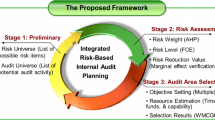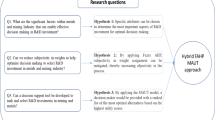Abstract
Internal audit function is an important cornerstone of corporate governance. Selecting qualified internal audit professionals has become a key success factor for any organization. However, research on the selection of internal auditors has limited exposure in the literature. In addition, prior research on personnel selection has only focused on applying traditional ranking methods, which calculate the overall utility value for each candidate and rank candidates in terms of the score. Little has been done for considering management’s goals regarding the attributes of the desired candidate. A robust model has not been constructed to address multiple aspiration levels for each goal in the classical personnel selection process. To fill these gaps, a novel generic framework is presented to evaluate and select ideal internal auditors, based on the analytic hierarchy process, fuzzy comprehensive evaluation, and weighted multi-choice goal programming. A case study is conducted to validate the feasibility and flexibility of the proposed approach. The results show that the proposed hybrid approach can assist decision-makers in selecting the candidate who is a good match for organizational needs. The implications of the paper are not restricted to the selection of internal auditors.



Similar content being viewed by others
Explore related subjects
Discover the latest articles, news and stories from top researchers in related subjects.References
Tang, F., Norman, C.S., Vendrzyk, V.P.: Exploring perceptions of data analytics in the internal audit function. Behav. Inf. Technol. 36(11), 1125–1136 (2017)
Wang, X., Ferreira, F.A.F., Chang, C.-T.: Multi-objective competency-based approach to project scheduling and staff assignment: case study of an internal audit project. Socioecon. Plann. Sci. (2021). https://doi.org/10.1016/j.seps.2021.101182
Abbott, L.J., Daugherty, B., Parker, S., Peters, G.F.: Internal audit quality and financial reporting quality: the joint importance of independence and competence. J. Account. Res. 54(1), 3–40 (2016)
Nurdiono, N., Gamayuni, R.R.: The effect of internal auditor competency on internal audit quality and its implication on the accountability of local government. Eur. Res. Stud. J. XXI(4), 426–434 (2018)
Salgado, J.F., De Fruyt, F.: Personality in personnel selection. In: Evers, A., Anderson, N., Voskuijl, O. (eds.) The Blackwell Handbook of Personnel Selection, pp. 174–198. Blackwell Publishing Ltd, Oxford (2017)
Chaghooshi, A., Arab, A., Dehshiri, S.: A fuzzy hybrid approach for project manager selection. Decis. Sci. Lett. 5(3), 447–460 (2016)
Kilic, H.S., Demirci, A.E., Delen, D.: An integrated decision analysis methodology based on IF-DEMATEL and IF-ELECTRE for personnel selection. Decis. Support Syst. 137, 113360 (2020). https://doi.org/10.1016/j.dss.2020.113360
Erdem, M.B.: A fuzzy analytical hierarchy process application in personnel selection in IT companies: a case study in a spin-off company. Acta Phys. Pol. A 130(1), 331–334 (2016)
Güngör, Z., Serhadlıoğlu, G., Kesen, S.E.: A fuzzy AHP approach to personnel selection problem. Appl. Soft Comput. 9(2), 641–646 (2009)
Varmazyar, M., Nouri, B.: A fuzzy AHP approach for employee recruitment. Decis. Sci. Lett. 3(1), 27–36 (2014). Accessed 11 March 2021
Dadeviren, M.: A hybrid multi-criteria decision-making model for personnel selection in manufacturing systems. J. Intell. Manuf. 21(4), 451–460 (2010)
Efe, B., Kurt, M.: A systematic approach for an application of personnel selection in assembly line balancing problem. Int. Trans. Oper. Res. 25(3), 1001–1025 (2018)
Nabeeh, N.A., Smarandache, F., Abdel-Basset, M., El-Ghareeb, H.A., Aboelfetouh, A.: An integrated Neutrosophic-TOPSIS approach and its application to personnel selection: a new trend in brain processing and analysis. IEEE Access 7, 29734–29744 (2019)
Samanlioglu, F., Taskaya, Y.E., Gulen, U.C., Cokcan, O.: A fuzzy AHP–TOPSIS-based group decision-making approach to IT personnel selection. Int. J. Fuzzy Syst. 20(5), 1576–1591 (2018)
Afshari, A., Mojahed, M., Yusuff, R.M.: Simple additive weighting approach to personnel selection problem. Int. J. Innov. Manage. Technol. 1(5), 511–515 (2010)
Krishankumar, R., Premaladha, J., Ravichandran, K.S., Sekar, K.R., Manikandan, R., Gao, X.Z.: A novel extension to VIKOR method under intuitionistic fuzzy context for solving personnel selection problem. Soft Comput. 24(2), 1063–1081 (2020)
Salehi, K.: An integrated approach of fuzzy AHP and fuzzy VIKOR for personnel selection problem. Global J. Manage. Stud. Res. 3(3), 89–95 (2016)
Chen, C., Hwang, Y., Hung, W. Applying multiple linguistic PROMETHEE method for personnel evaluation and selection. In: 2009 IEEE International Conference on Industrial Engineering and Engineering Management, Hong Kong, China (2009)
de Farias-Aires, R.F., Ferreira, L.: The rank reversal problem in multi-criteria decision making: a literature review. Pesqui. Oper. 38(2), 331–362 (2018)
Hoffman, J.J., Schniederjans, M.J., Sebora, T.C.: A multi-objective approach to CEO selection. INFOR Inf. Syst. Oper. Res. 42(4), 237–255 (2004)
Kelemenis, A., Askounis, D.: A new TOPSIS-based multi-criteria approach to personnel selection. Expert Syst. Appl. 37(7), 4999–5008 (2010)
Kelemenis, A., Ergazakis, K., Askounis, D.: Support managers’ selection using an extension of fuzzy TOPSIS. Expert Syst. Appl. 38(3), 2774–2782 (2011)
Saad, R.M., Ahmad, M.Z., Abu, M.S., Jusoh, M.S.: Hamming distance method with subjective and objective weights for personnel selection. Sci. World J. (2014). https://doi.org/10.1155/2014/865495
Seol, I., Sarkis, J.: A multi-attribute model for internal auditor selection. Manage. Audit. J. 20(8), 876–892 (2005)
Seol, I., Sarkis, J.: A model for internal auditor selection: the case of a trading company in Hong Kong. Int. J. Audit. 10(3), 243–253 (2006)
Sarkis, J., Seol, I.: An analytic network process model for internal auditor selection. In: Kenneth, D.L., Ronald, K.K. (eds.) Applications of Management Science: In Productivity, Finance, and Operations, vol. 12, pp. 215–234. Emerald Group Publishing Limited, Bingley (2006)
Prasad, R.: Selection of internal safety auditors in an Indian construction organization based on the SWARA and ARAS methods. JOHE 8(3), 134–140 (2019)
Petridis, K., Drogalas, G., Zografidou, E.: Internal auditor selection using a TOPSIS/non-linear programming model. Ann. Oper. Res. 296(1), 513–539 (2021)
Mihret, D.G., Grant, B.: The role of internal auditing in corporate governance: a Foucauldian analysis. Account. Audit. Account. J. 30(3), 699–719 (2017)
Zhang, D., Yang, S., Wang, Z., Yang, C., Chen, Y.: Assessment of ecological environment impact in highway construction activities with improved group AHP-FCE approach in China. Environ. Monit. Assess. 192(7), 451 (2020)
Yang, J., Shen, L., Jin, X., Hou, L., Shang, S., Zhang, Y.: Evaluating the quality of simulation teaching in fundamental nursing curriculum: AHP-Fuzzy comprehensive evaluation. Nurse Educ. Today 77, 77–82 (2019)
Guo, Z., Zhou, D., Zhou, Q., Mei, S., Zeng, S., Yu, D., Chen, J.: A hybrid method for evaluation of maintainability towards a design process using virtual reality. Comput. Ind. Eng. 140, 106227 (2020). https://doi.org/10.1016/j.cie.2019.106227
Darko, A., Chan, A.P.C., Ameyaw, E.E., Owusu, E.K., Pärn, E., Edwards, D.J.: Review of application of analytic hierarchy process (AHP) in construction. Int. J. Constr. Manage. 19(5), 436–452 (2019)
Aggarwal, R.: Identifying and prioritizing human capital measurement indicators for personnel selection using fuzzy MADM. In: Pant, M. Deep, K., Nagar, A., Bansal J. C. (eds) Proceedings of the Third International Conference on Soft Computing for Problem Solving, pp. 427–439. Springer, Berlin (2014)
Menekse, A., Camgoz-Akdag, H.: Internal audit planning using spherical fuzzy ELECTRE. Appl. Soft Comput. 114, 108155 (2022). https://doi.org/10.1016/j.asoc.2021.108155
Zadeh, L.A.: Fuzzy sets. Inf. Control 8(3), 338–353 (1965)
Wang, B., Mo, C., He, C., Yan, Q.: Fuzzy synthetic evaluation of the long-term health of tunnel structures. Appl. Sci. 7(2), 203 (2017)
Zhang, X., Yang, J., Zhao, X.: Optimal study of the rural house space heating systems employing the AHP and FCE methods. Energy 150, 631–641 (2018)
Colapinto, C., Jayaraman, R., Marsiglio, S.: Multi-criteria decision analysis with goal programming in engineering, management and social sciences: a state-of-the art review. Ann. Oper. Res. 251(1), 7–40 (2017)
Chang, C.-T.: Revised multi-choice goal programming. Appl. Math. Model. 32(12), 2587–2595 (2008)
Hocine, A., Zhuang, Z.-Y., Kouaissah, N., Li, D.-C.: Weighted-additive fuzzy multi-choice goal programming (WA-FMCGP) for supporting renewable energy site selection decisions. Eur. J. Oper. Res. 285(2), 642–654 (2020)
Mehlawat, M.K.: Credibilistic mean-entropy models for multi-period portfolio selection with multi-choice aspiration levels. Inf. Sci. 345, 9–26 (2016)
Liao, C.-N., Lin, C.-H., Fu, Y.-K.: Integrative model for the selection of a new product launch strategy, based on ANP, TOPSIS and MCGP: a case study. Technol. Econ. Dev. Econ. 22(5), 715–737 (2016)
Ho, H.-P.: The supplier selection problem of a manufacturing company using the weighted multi-choice goal programming and MINMAX multi-choice goal programming. Appl. Math. Model. 75, 819–836 (2019)
Robertson, I.T., Smith, M.: Personnel selection. J. Occup. Organ. Psychol. 74(4), 441–472 (2001)
Kotb, A., Elbardan, H., Halabi, H.: Mapping of internal audit research: a post-Enron structured literature review. Account. Audit. Account. J. 33(8), 1969–1996 (2020)
Coetzee, P., Erasmus, L.J., Plant, K.: Global assessment of internal audit competence: does one size fi t all? South. Afr. Bus. Rev. 19(2), 1–21 (2015)
Gartner: Audit Skills Diagnostic. Gartner, Inc, Stamford (2020)
IIA: Internal Audit Competency Framework. The Institute of Internal Auditors, Lake Mary (2020)
Mohd Ali, N.A., Shafii, Z., Shahimi, S.: Competency model for Shari’ah auditors in Islamic banks. J. Islam. Account. Bus. Res. 11(2), 377–399 (2020)
Fulton, D., Parchure, N.: Implementing a shared services model: when consolidating services, internal audit’s broad knowledge of the business works to the organization’s advantage. Intern. Auditor 75(1), 43–47 (2018)
van Kuijck, B., Paresi, V.: Personality of internal auditors; an exploratory study in The Netherlands. Maandbl. Voor Account. Bedrijfsecon. 94(3/4), 113–125 (2020)
Everett, J., Tremblay, M.-S.: Ethics and internal audit: moral will and moral skill in a heteronomous field. Crit. Perspect. Account. 25(3), 181–196 (2014)
DeZoort, T., Doxey, M., Pollard, T.: Root cause analysis and its effect on auditors’ judgments and decisions in an integrated audit. Contemp. Account. Res. 38(2), 1204–1230 (2021)
Elliott, M., Dawson, R., Edwards, J.: An improved process model for internal auditing. Manage. Audit. J. 22(6), 552–565 (2007)
Narkchai, S., Fadzil, F.H.B.: The communication skill on the performance of internal auditors in Thailand public limited company. Int. Rev. Manage. Mark. 7(4), 1–5 (2017)
Behrend, J., Eulerich, M.: The evolution of internal audit research: a bibliometric analysis of published documents (1926–2016). Account. Hist. Rev. 29(1), 103–139 (2019)
Christ, M. H., Eulerich, M., Krane, R., Wood, D. A.: New frontiers for internal audit research. SSRN. (2020). https://ssrn.com/abstract=3622148
Hocine, A., Kouaissah, N.: XOR analytic hierarchy process and its application in the renewable energy sector. Omega 97, 102082 (2020). https://doi.org/10.1016/j.omega.2019.06.008
Saaty, T.L.: The Analytic Hierarchy Process. McGraw Hill, New York (1980)
Kuo, Y.-F., Chen, P.-C.: Selection of mobile value-added services for system operators using fuzzy synthetic evaluation. Expert Syst. Appl. 30(4), 612–620 (2006)
Chang, T.-Y., Ku, C.C.-Y.: Fuzzy filtering ranking method for multi-criteria decision making. Comput. Ind. Eng. 156, 107217 (2021). https://doi.org/10.1016/j.cie.2021.107217
Schrage, L.: Optimization Modeling with LINGO, 6th edn. LINDO Systems Inc, Chicago (2006)
Seol, I., Sarkis, J., Wang, Z.: A cross-cultural comparative study of internal auditor skills: UK vs Korea. J. Appl. Account. Res. 18(3), 341–355 (2017)
Author information
Authors and Affiliations
Corresponding author
Appendices
Appendix 1
Decision-making sets on the ten main competencies for candidate A are expressed as follows:
Appendix 2
Final comprehensive evaluation set for candidate A is expressed as follows:
Appendix 3
The personnel selection decision model is formulated as follows:
Subject to
Rights and permissions
About this article
Cite this article
Wang, X., Ferreira, F.A.F., Tao, M. et al. A Hybrid AHP–FCE–WMCGP Approach for Internal Auditor Selection: A Generic Framework. Int. J. Fuzzy Syst. 24, 2229–2249 (2022). https://doi.org/10.1007/s40815-022-01266-3
Received:
Revised:
Accepted:
Published:
Issue Date:
DOI: https://doi.org/10.1007/s40815-022-01266-3




